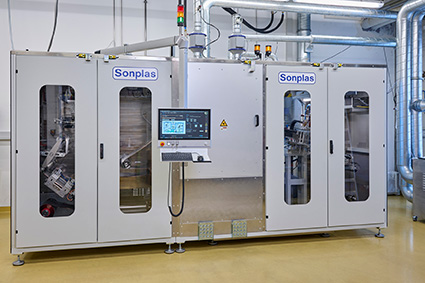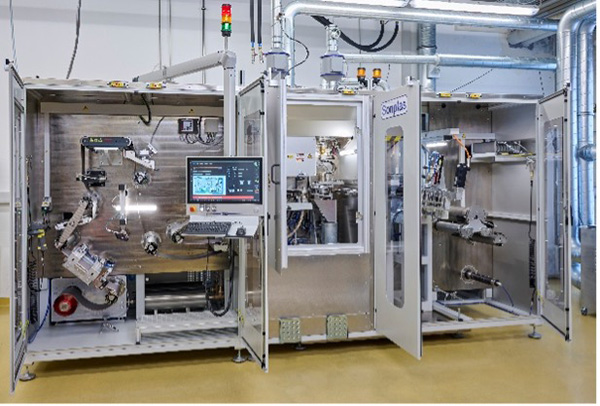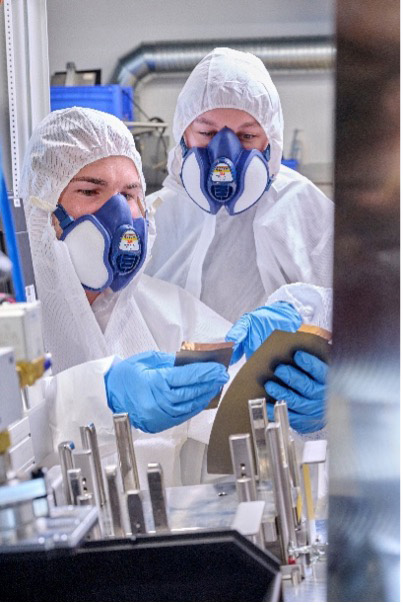Sonplas: Laser cutting as a cost-effective alternative to punching.

Sonplas has developed a laser cutting process that enables the efficient and sustainable processing of lithium-ion battery cell foils. This technology can also be applied across various industries, including paper, solar, and medical sectors, as well as hydrogen applications like H2 MEA. Especially for complex shapes, laser cutting proves to be far more cost-effective than traditional mechanical cutting or punching. It delivers higher quality, reduces operating costs, and offers greater flexibility. Sonplas collaborates closely with its customers to develop the ideal solution.
Achieving optimal cut edge quality is a key factor in electrode production,” says Luca Schmerbeck, Product Manager at Sonplas. The special-purpose machine manufacturer from Straubing designs, builds, and delivers customized testing and assembly systems, primarily for the automotive, electronics, and aerospace industries. In addition to assembling rotors, inverters, and other components for electric vehicles, Sonplas also specializes in battery cell production. “To enhance productivity, we provide solutions that allow our customers to cut battery foils using a laser-based roll-to-roll process, known as notching,” explains Sonplas expert Schmerbeck. In this process, the edges of the foils are trimmed on-the-fly.
The process operates at extremely high web speeds of up to four meters per second, ensuring that the electrodes remain free from particle contamination. Additionally, the system can handle different geometries without requiring any modifications. The largest electrodes on the market fall within the 700 × 700 millimeter machining range. “The results are highly accurate, and due to the low heat input in this contactless cutting process, a wide range of materials can be processed – from metal to paper – while maintaining consistently high cutting quality,” explains Schmerbeck. “This means we can apply this process to all industries where foil cutting needs to be cost-effective.” In sheet metal processing, lasers have become a core component of many manufacturing processes, offering a highly economical alternative to punching.
Which method is suitable depends on the application. Luca Schmerbeck explains: “The laser typically has a clear advantage, particularly in terms of edge and surface quality.” And what if complex contours or different components need to be processed alternately? That’s where laser cutting truly excels – it’s more efficient, faster, and more precise. The user also has more flexibility when switching products. While a laser can follow various contours and the operator can easily adjust parameters like material thickness, punching requires the right die for each component and material. The die wears out due to the punched materials and needs to be sharpened or even replaced. This leads to downtime and material costs, which can make the use of a laser quickly pay for itself, depending on the operating time. Here, the laser clearly has the advantage. In sheet metal processing, for example, individual parts or small batches can be produced cost-effectively in a single operation without the need to change tools.
Due to its versatility, operators can utilize laser cutting in a variety of industries, including fuel cell technology. In the automotive industry, fuel cells are seen as a promising solution for future energy generation.To produce them cost-effectively and with high-quality standards suitable for the mass market, manufacturers are increasingly turning to lasers. They use it to precisely cut metal sheets as thin as 100 micrometers and then weld them into gas-tight stacks wireliable precision. “At Sonplas, we can currently process thicknesses ranging from eight to 300 micrometers,” promises Schmerbeck. The process is also suitable for the medical technology sector, such as in the production of filters. This is mainly due to the low heat input during the non-contact processing with the laser beam, which results in distortion-free cutting. The thermal laser process also seals the cut edges when cutting synthetic textiles. “The user benefits from clean and reproducible cut edges, with no need for post-processing,” explains the product manager.
“Actually, we can envision many more industries as well.” says the Sonplas expert. One of them is printed electronics, where electronic components, assemblies, and applications are produced fully or partially using printing processes. The electronics printed on plastic film can be precisely cut out using a laser.
“Together with the customer, we at Sonplas find the perfect solution. After all, there’s a suitable laser for every material on a roll,” says Schmerbeck. “We have the in-house expertise to offer optimal advice and design the right system technology for our customers.”




Sonplas GmbH:
Sonplas is a medium-sized mechanical engineering company headquartered in Straubing, Lower Bavaria. Since its establishment in 1993, the company has experienced steady growth. Sonplas now employs around 390 highly motivated employees.
In alignment with the motto “For your success,” Sonplas specializes in developing flexible and scalable special-purpose machines for processing, assembly, and testing. These can be complemented with external technologies as per the customer’s specifications. Over the years, the portfolio has consistently grown, and the special-purpose machine manufacturer now provides solutions for various sectors including electromobility, battery cell production, hydrogen technology, hydro-erosive machining, fuel injection, electronics, mechatronics, hydraulics, and aerospace technology. To date, the company has delivered over 1,000 special-purpose machines worldwide to renowned clients in the automotive, automotive supply, commercial vehicle industries, and aviation technology sector.
With its in-house research and development department, Sonplas consistently meets the latest technical demands in the market. With service partners worldwide and a subsidiary in China, the company also provides customers with expert support and spare parts directly on-site. What sets Sonplas apart? Sonplas stands out for its profound expertise and thorough understanding of processes. Sonplas operates as both a system integrator and a general contractor. Sonplas delivers tailored solutions of the utmost quality to its customers.
In this episode, I sat down with Beejan Giga, Director | Partner and Caleb Emerson, Senior Results Manager at Carpedia International. We discussed the insights behind their recent Industry Today article, “Thinking Three Moves Ahead” and together we explored how manufacturers can plan more strategically, align with their suppliers, and build the operational discipline needed to support intentional, sustainable growth. It was a conversation packed with practical perspectives on navigating a fast-changing industry landscape.